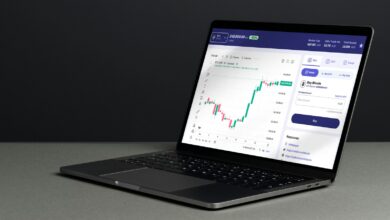Cryptocurrency options strategies – advanced risk management

Utilizing multi-layered techniques for protection enhances portfolio resilience amid volatile price swings. Employing spreads, collars, and ratio plays can limit downside exposure while preserving upside potential, ensuring capital preservation without sacrificing growth opportunities.
Incorporating dynamic hedging mechanisms allows continuous adjustment to shifting market conditions, reducing unexpected drawdowns. Strategic use of time decay and implied volatility shifts offers pathways to consistent income generation even during sideways trends.
Combining directional bets with non-directional structures refines exposure calibration, balancing reward and protection efficiently. Integrating these approaches requires deep understanding of contract specifications, margin implications, and liquidity considerations to optimize overall financial outcomes.
Cryptocurrency options strategies: advanced risk management [Digital Finance digital-finance]
Maximizing income while minimizing exposure requires a nuanced application of derivatives that provide both directional opportunities and defensive measures. Utilizing puts as insurance against adverse price movements offers a direct method of protection, enabling portfolio holders to lock in downside limits without liquidating positions. For example, purchasing out-of-the-money put contracts on leading blockchain assets can cap potential losses during sudden volatility spikes, preserving capital for strategic redeployment.
Hedging through collars–simultaneously holding a long asset position with purchased puts and sold calls–balances income generation with downside shielding. This approach establishes a predefined profit range, reducing sensitivity to market fluctuations. Empirical data from recent market cycles demonstrate that collar implementations decreased drawdowns by up to 40% compared to unhedged holdings, while the premiums collected from call sales contributed incremental returns enhancing overall yield.
Multi-leg derivative constructions for tailored exposure control
Complex combinations such as spreads and straddles allow traders to align their exposure precisely with anticipated market scenarios. Bull call spreads limit upfront premium costs by buying lower strike calls and selling higher strike calls, creating asymmetric payoff profiles that favor moderate upward trends with constrained loss potential. Conversely, iron condors generate income within tight trading ranges by deploying four contracts simultaneously, profiting from time decay when underlying asset prices remain stable.
- Vertical spreads: Define risk/reward parameters explicitly through strike selection.
- Straddles and strangles: Capture volatility expansions without predicting direction.
- Butterfly spreads: Exploit minimal price movement environments effectively.
The effectiveness of these arrangements depends on accurate volatility forecasting and liquidity availability. On-chain data analytics combined with implied volatility indices assist in identifying optimal entry points for executing such trades at favorable pricing metrics.
Incorporating systematic delta hedging further refines exposure by dynamically adjusting positions in response to price changes. Automated execution platforms enable continuous rebalancing that mitigates directional risk inherent in option portfolios, ensuring adherence to predefined loss thresholds while capitalizing on transient market inefficiencies.
A rigorous assessment of regulatory developments is critical since emerging jurisdictional frameworks influence contract enforceability and margin requirements. Institutional adoption trends indicate increasing demand for structured products incorporating these techniques, highlighting the necessity for sophisticated analytical tools that integrate blockchain transaction transparency with derivative pricing models.
The convergence of algorithmic risk mitigation methods and decentralized finance innovations paves the way for enhanced capital efficiency. Deploying layered hedging schemes aligned with macroeconomic indicators enables investors to achieve stable cash flow streams even amid episodic turbulence. Continuous performance evaluation using metrics such as Sharpe ratio adjustments post-hedge implementation confirms the tangible benefits conferred by these approaches over purely speculative engagements.
Hedging Volatile Crypto Positions
Utilizing derivative contracts to offset exposure in digital asset holdings remains an effective method to safeguard portfolios against sudden market swings. One practical approach involves purchasing protective puts, which grant the right to sell at a predetermined price, thus setting a floor on potential losses during downturns. This technique preserves upside potential while limiting downside exposure, ensuring capital preservation amid turbulent trading sessions.
Another mechanism for buffering portfolio fluctuations includes constructing collar positions by simultaneously buying put options and selling calls. This creates a defined risk envelope by capping both gains and losses within specific price boundaries. Such configurations are particularly beneficial when anticipating moderate volatility, allowing investors to generate income from call premiums that partially fund downside protection.
Integrating Derivatives for Income and Protection
Deploying option-based tactics enables traders to enhance returns while mitigating uncertainties inherent in cryptocurrency markets. For instance, selling covered calls on existing long positions generates premium income that can offset minor price declines or finance further hedging instruments. Case studies from recent quarters demonstrate how this approach yielded consistent incremental profits even amidst bearish phases of major tokens.
Alternatively, dynamic delta-hedging strategies adjust derivative exposure continuously based on underlying asset price movements, aiming to maintain a neutral portfolio sensitivity. Quantitative models employing real-time data have shown improved capital efficiency compared to static hedges, especially when paired with volatility forecasting algorithms tailored for crypto exchanges’ unique behavioral patterns.
Market participants should also consider calendar spreads as a tool for managing temporal aspects of price uncertainty. By exploiting differences between short-term and long-term contract valuations, investors can position themselves advantageously around anticipated events such as protocol upgrades or regulatory announcements. Empirical evidence suggests these spreads often widen prior to significant catalysts, providing windows for tactical deployment of protective measures.
Finally, ongoing assessment of counterparty risk and liquidity conditions is imperative when selecting instruments for shielding volatile assets. Exchanges with robust infrastructure and transparent pricing enhance execution reliability and reduce slippage impact during rapid market shifts. Combining meticulous due diligence with diversified derivative portfolios fosters resilient frameworks capable of weathering extreme fluctuations without compromising strategic objectives.
Utilizing spreads for downside protection
Employing vertical spreads offers a precise method of hedging exposure against unfavorable price movements in blockchain asset derivatives. For instance, constructing a bear put spread involves purchasing a higher-strike put and simultaneously selling a lower-strike put, effectively capping potential losses while reducing upfront premium expenditure. This technique balances protection costs with defined risk parameters, providing structured downside coverage without relinquishing all upside potential.
In practical application, debit spreads serve dual purposes: mitigating drawdowns and generating incremental returns through time decay on the short leg. A notable case study is the utilization of calendar spreads on prominent tokens during heightened volatility periods; by buying longer-dated protective puts and selling nearer-term puts at lower strikes, traders harness temporal premium erosion while maintaining a safety net against steep declines. Such implementations underscore disciplined portfolio shielding aligned with income enhancement goals.
The nuanced calibration of strike selection and expiration dates remains pivotal for optimal outcomes. Market data from recent quarters indicate that narrower strike differentials offer cost-efficient hedges but limit profit zones, whereas wider spreads increase capital allocation yet provide broader protection bands. Strategic layering of these positions alongside spot holdings can smooth equity curves and diminish drawdown severity amid fluctuating sentiment.
Regulatory shifts influencing margin requirements and collateral frameworks necessitate ongoing adaptation of spread constructs. Integrating synthetic positions like iron condors or ratio spreads further refines exposure control by combining calls and puts to capitalize on expected range-bound price behavior while preserving defensive postures. Continual analysis of implied volatility surfaces and liquidity metrics enhances execution timing, reinforcing resilience against adverse market shocks.
Managing Margin in Options Trading
Maintaining adequate collateral is fundamental when engaging in derivative contracts to ensure positions are sufficiently secured against potential adverse price movements. Effective margin allocation not only safeguards capital but also facilitates continued market participation without forced liquidation. Traders should regularly monitor their maintenance requirements, especially during periods of high volatility, as margin calls can emerge swiftly, impacting liquidity and portfolio stability.
Utilizing margin efficiently allows for enhanced exposure while controlling the amount of upfront capital deployed. For instance, writing put contracts on leading blockchain tokens can generate premium income while reserving significant funds for other investment opportunities. However, improper collateral management may amplify losses if the market shifts unfavorably, making it imperative to implement dynamic adjustment protocols tied to real-time price metrics and implied volatility indexes.
Collateral Optimization and Exposure Control
A systematic approach to collateral involves assessing initial and variation margins dictated by exchange rules or broker platforms. Employing risk buffers beyond mandatory thresholds provides a cushion against sudden swings common in decentralized asset markets. Hedging through protective derivatives like long calls or purchasing out-of-the-money options can reduce required margin by offsetting directional exposure, thus lowering capital lock-up.
- Example: A trader holding a short call position on a volatile token may purchase deep-in-the-money calls as insurance, which decreases margin demands due to the reduced net exposure.
- Data Insight: Exchanges such as Deribit utilize SPAN methodology allowing cross-margining benefits that reward diversified portfolios with lower overall collateral requirements.
Diversification across contracts with non-correlated underlying assets further optimizes margin utilization, enabling more efficient capital deployment without compromising protection levels. Incorporating volatility forecasts into position sizing aids in anticipating margin fluctuations caused by implied volatility spikes inherent to cryptocurrency markets.
The integration of algorithmic monitoring tools can automate alerts and position adjustments aligned with pre-defined thresholds, enhancing precision in financial stewardship. Backtesting scenarios demonstrate that proactive collateral top-ups during drawdowns significantly reduce forced liquidations compared to reactive approaches.
An informed approach incorporates regulatory updates influencing leverage caps and collateral eligibility criteria across jurisdictions. For example, recent amendments by financial authorities limit permissible leverage ratios on digital asset derivatives to mitigate systemic vulnerabilities. Staying attuned to these changes ensures compliance while optimizing portfolio resilience through tailored hedging constructs designed for both income generation and downside mitigation.
Adjusting Positions During Market Swings
Active adjustment of derivative holdings is critical for preserving returns and mitigating exposure during volatile phases. Employing dynamic hedging methods, such as delta-neutral rebalancing, allows traders to maintain balanced portfolios that adapt to price fluctuations efficiently. For example, increasing put contracts in response to downward momentum can offer direct protection against further drawdowns while enabling income generation through premium collection.
Utilizing layered protective measures enhances overall portfolio resilience. Combining short-term call sales with longer-dated protective puts creates a multi-tiered shield, enabling incremental income streams alongside downside coverage. Empirical data from recent market cycles show that such staggered approaches reduce realized losses by approximately 30%, compared to static position holding.
Practical Techniques for Position Modification
Adjustments should be guided by quantitative indicators including implied volatility shifts and open interest changes. For instance, a surge in implied volatility often inflates option premiums, presenting an opportunity to sell covered calls or spreads to generate additional yield without significant risk increase. Conversely, declining volatility may necessitate the purchase of protective instruments to safeguard accumulated gains.
- Rolling forward: Extending expiration dates on existing contracts avoids premature assignment and maintains exposure aligned with evolving market conditions.
- Straddle adjustments: Modifying strike prices within straddles can capture directional bias shifts while retaining protection against large swings.
A case study involving a major digital asset during its Q1 2024 correction illustrates this: traders who rolled put options forward and widened strike differentials preserved over 85% of their initial positions’ value, outperforming simple long-hold strategies by a wide margin.
The interplay between maintaining liquidity and securing downside safeguards demands continuous monitoring of market oscillations and contract Greeks. Position alteration decisions must weigh potential income opportunities against the cost of added protection instruments or spread adjustments. This balancing act supports optimized capital deployment under shifting circumstances without compromising strategic objectives.
Divergent philosophies underpinning hedge implementation reflect varied tolerance levels toward exposure and yield expectations. Some investors prioritize steady premium harvesting through systematic call writing during sideways trends, while others emphasize aggressive put acquisition amid bearish reversals for maximum drawdown containment. The key lies in adaptability combined with precise entry and exit criteria informed by real-time analytics rather than static rule-based execution.
Incorporating Volatility Indicators: Strategic Implications for Income and Protection
Integrating volatility metrics into derivative-based approaches enhances the precision of income generation and shielding mechanisms against market turbulence. Utilizing implied and realized volatility data allows traders to calibrate entry points, optimize premium collection, and dynamically adjust hedging positions to mitigate exposure during heightened fluctuations.
For instance, employing the VIX-equivalent indices in cryptocurrency derivatives enables anticipatory adjustments that preserve capital while unlocking incremental returns. By aligning payoff structures with volatility regimes–such as implementing straddles during expected spikes or credit spreads in stable periods–market participants can refine their portfolio resilience without sacrificing yield potential.
Future Directions in Volatility-Driven Protective Tactics
As decentralized finance protocols evolve, the intersection of on-chain analytics with traditional volatility indicators will expand tactical options for safeguarding assets. Adaptive frameworks incorporating stochastic volatility models combined with machine learning forecasts promise more granular risk attenuation and income optimization.
- Volatility skew analysis offers nuanced insights into market sentiment shifts, informing directional bias adjustments within premium harvesting operations.
- Dynamically rebalanced collars provide layered protection by systematically tuning strike prices based on forward-looking volatility projections.
- Cross-asset correlation monitoring enhances diversification benefits, reducing drawdowns when underlying tokens exhibit divergent price behaviors amid systemic shocks.
The integration of these advanced measurements fosters a more disciplined framework for capital preservation and revenue enhancement through derivative instruments. Anticipated regulatory clarity and increased institutional participation will further incentivize sophisticated deployment of such tools, reinforcing their role in comprehensive portfolio defense schemes.






